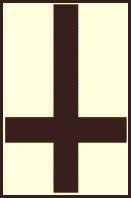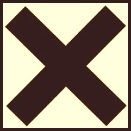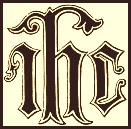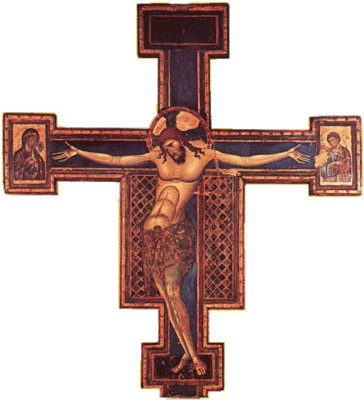The Cross in Christian Art
Q: I see many different types or styles of crosses. Could you please tell me about some of these and show any special meanings they might have?
 The “basic” cross in Western Christendom is the so-called Latin Cross. It gets its name from a stereotypical understanding of the style used in Roman crucifixions, including that of Jesus Christ. Actually, the Romans used whatever shape was available, although this one, with the long pole and shorter cross-arm, may have been most common and may certainly have been the style used as our Savior’s sacrificial altar.
The “basic” cross in Western Christendom is the so-called Latin Cross. It gets its name from a stereotypical understanding of the style used in Roman crucifixions, including that of Jesus Christ. Actually, the Romans used whatever shape was available, although this one, with the long pole and shorter cross-arm, may have been most common and may certainly have been the style used as our Savior’s sacrificial altar. If you see the Latin Cross standing on a base made of three steps leading up to it, it’s called the Calvary Cross. The steps remind us of the hill upon which Christ died. They are often said to represent the three great gifts of the Spirit, faith, hope, and charity (love). I’ve seen many brass altar crosses using this Calvary form as their basic design.
If you see the Latin Cross standing on a base made of three steps leading up to it, it’s called the Calvary Cross. The steps remind us of the hill upon which Christ died. They are often said to represent the three great gifts of the Spirit, faith, hope, and charity (love). I’ve seen many brass altar crosses using this Calvary form as their basic design. If the crossbar is moved to the top, it’s called a T Cross or Tau Cross or, sometimes, a Saint Anthony Cross. An inverted Latin Cross is sometimes used in unchristian ceremonies as sort of an “anti-Christian” emblem. However, long before the blasphemies of Satanism, Wicca, and Paganism, Christians used this same upside-down Latin cross as the Cross of Saint Peter, since ancient tradition said that he asked to be crucified head down, not considering himself worthy of dying upright, as had his Lord.
If the crossbar is moved to the top, it’s called a T Cross or Tau Cross or, sometimes, a Saint Anthony Cross. An inverted Latin Cross is sometimes used in unchristian ceremonies as sort of an “anti-Christian” emblem. However, long before the blasphemies of Satanism, Wicca, and Paganism, Christians used this same upside-down Latin cross as the Cross of Saint Peter, since ancient tradition said that he asked to be crucified head down, not considering himself worthy of dying upright, as had his Lord. The Cross of Saint Andrew (sometimes called the Cross Saltire) is “X” shaped. Its name comes from an ancient story of the apostle’s martyrdom. St. Andrew’s Cross is the emblem of Scotland and is included as part of the British Union Jack, since Andrew is Scotland’s patron saint.
The Cross of Saint Andrew (sometimes called the Cross Saltire) is “X” shaped. Its name comes from an ancient story of the apostle’s martyrdom. St. Andrew’s Cross is the emblem of Scotland and is included as part of the British Union Jack, since Andrew is Scotland’s patron saint.This X shape sometimes aids visual wordplay. In Greek, the letter “X” is called chi. It has a sound similar to the German “ch” and is the first letter in the word “Christ.” In religious art, this “X” may represent both a cross and the title of the One who died on a cross to save us from our sins.
 Related to the X shape is the Chi Rho Cross, based upon the stylized Greek monogram for Christ (Χρυστος) that superimposes the Greek letters chi (Χ) and rho (Ρ). An earlier column, Putting the “X” Back in Christmas, discussed this icon of Christian art, so I’ll not go into all the details now. However, for this discussion of crosses, it’s worth noting that at times, the chi is rotated and only a horizontal cross bar appears, as shown in this image.
Related to the X shape is the Chi Rho Cross, based upon the stylized Greek monogram for Christ (Χρυστος) that superimposes the Greek letters chi (Χ) and rho (Ρ). An earlier column, Putting the “X” Back in Christmas, discussed this icon of Christian art, so I’ll not go into all the details now. However, for this discussion of crosses, it’s worth noting that at times, the chi is rotated and only a horizontal cross bar appears, as shown in this image. The monogram for the title of Christ isn’t alone in getting special “cross treatment” from various Christian artists. Similarly, the abbreviation for the name Jesus (Ιησους) also enters the realm of stylized crosses as the IHS Cross. As with the Chi Rho, so I’ve also previously written on IHS (ΙΗΣ). The characters iota (ι), eta (η), and sigma (ς) represent the first two and the final letters of His Greek name.
The monogram for the title of Christ isn’t alone in getting special “cross treatment” from various Christian artists. Similarly, the abbreviation for the name Jesus (Ιησους) also enters the realm of stylized crosses as the IHS Cross. As with the Chi Rho, so I’ve also previously written on IHS (ΙΗΣ). The characters iota (ι), eta (η), and sigma (ς) represent the first two and the final letters of His Greek name.In the English language, we’re accustomed to using an apostrophe to indicate missing letters and, usually, a period to note an abbreviation. In Greek, a long horizontal bar above the letters often showed that part of a word was missing. It’s very easy when writing the eta to extend its vertical arm, allowing the abbreviation mark to join it in forming a cross, as shown here.
 Looking like a sign of addition (+), a regular, unadorned cross with arms of equal length is often called a Greek Cross. It differs from the Latin Cross only in that its two beams intersect in each others’ centers and all four arms are of equal length. Sometimes this cross stands alone. However, its simple design readily lends itself to use in more elaborate patterns.
Looking like a sign of addition (+), a regular, unadorned cross with arms of equal length is often called a Greek Cross. It differs from the Latin Cross only in that its two beams intersect in each others’ centers and all four arms are of equal length. Sometimes this cross stands alone. However, its simple design readily lends itself to use in more elaborate patterns. On very common variant of the Greek Cross including four smaller crosses in the open fields is called a Jerusalem Cross or a Crusaders’ Cross. It was popular during the Crusades and the five crosses are often said to symbolize the five wounds of Christ that He received on the tree. In this image, the central Greek Cross is drawn as a Cross Potent. Its four arms are each capped with short beams and every arm resembles a crutch. The shape gives name to the Cross Potent, since “potent” is an old word for a crutch. Surrounding this larger Cross Potent we see four standard Greek Crosses.
On very common variant of the Greek Cross including four smaller crosses in the open fields is called a Jerusalem Cross or a Crusaders’ Cross. It was popular during the Crusades and the five crosses are often said to symbolize the five wounds of Christ that He received on the tree. In this image, the central Greek Cross is drawn as a Cross Potent. Its four arms are each capped with short beams and every arm resembles a crutch. The shape gives name to the Cross Potent, since “potent” is an old word for a crutch. Surrounding this larger Cross Potent we see four standard Greek Crosses. Next, I include an illustration of the Byzantine Cross. Its basic shape is that of the Latin Cross but it includes a small upper cross beam that represents (according to various sources) either the headboard against which Jesus leaned or else the plaque upon which Pilate placed the inscription. This basic shape is laid upon a fancy background wherein the three rounded sections at the end of each arm remind the viewer of the Trinity. IC (ΙΣ) and XC (ΧΣ) are abbreviations for “Jesus Christ” in Greek.
Next, I include an illustration of the Byzantine Cross. Its basic shape is that of the Latin Cross but it includes a small upper cross beam that represents (according to various sources) either the headboard against which Jesus leaned or else the plaque upon which Pilate placed the inscription. This basic shape is laid upon a fancy background wherein the three rounded sections at the end of each arm remind the viewer of the Trinity. IC (ΙΣ) and XC (ΧΣ) are abbreviations for “Jesus Christ” in Greek.The cross in the center of this image is also used as a Patriarchal Cross among the Eastern Orthodox. It denotes the spiritual leaders of various parts of Orthodoxy. The angled bottom beam is said to be the footboard that was bent out of place as Jesus twisted in agony. Some also claim that this small beam is a stylized Cross of Saint Andrew, since they believe that Andrew carried the Gospel into the East. Others treat it as an indication that the “scandal” (or “stumbling block”) of Christ’s crucifixion (see 1 Corinthians 1:22-25) provides the divide at which some ascend into heaven while others descend into hell.
You may sometimes see Latin crosses with three upper beams, getting larger from top to bottom. This is a traditional sign of the Roman papacy, depicting Rome’s claim that the Pope is Bishop of Rome, Patriarch of the West, and successor of St. Peter, Chief of the Apostles.
 Another common symbol, the Cross of Victory (or Cross of Triumph) also picks up on the IC XC abbreviations. While someone might be tempted to pronounce these characters as one word (icxcnika), they actually are the abbreviations for Jesus and Christ (see the Byzantine Cross, above) with the Greek word for victory (Νικα). This word actually descended from the Greek goddess of victory, whose name also became the trade name of Nike, the athletic shoe manufacturer. Often, you’ll see the horizontal abbreviation bars above the IC and the XC, as noted above with the Chi Rho and IHS Crosses.
Another common symbol, the Cross of Victory (or Cross of Triumph) also picks up on the IC XC abbreviations. While someone might be tempted to pronounce these characters as one word (icxcnika), they actually are the abbreviations for Jesus and Christ (see the Byzantine Cross, above) with the Greek word for victory (Νικα). This word actually descended from the Greek goddess of victory, whose name also became the trade name of Nike, the athletic shoe manufacturer. Often, you’ll see the horizontal abbreviation bars above the IC and the XC, as noted above with the Chi Rho and IHS Crosses. Because of the beauty of its intertwined geometric cords, the Celtic Cross is one of the most popular depictions of our Savior’s cross. Ancient freestanding carved stones in this shape dot much of Ireland, Scotland, and parts of England.
Because of the beauty of its intertwined geometric cords, the Celtic Cross is one of the most popular depictions of our Savior’s cross. Ancient freestanding carved stones in this shape dot much of Ireland, Scotland, and parts of England.Some scholars, believing that the Chi Rho was used before the Latin Cross in Western Christianity, think that the Celtic people began to blend its features into a more familiar cross shape with the circle remaining from the loop of the rho. This may be, but it’s certainly also true that larger carved stone crosses are rather weak and gravity, coupled with weathering in outdoor installations, can cause their arms to drop off. The wreath of the Celtic Cross thus also provides a tremendously stronger support — a strength displayed throughout the long centuries that many of these have stood.
While this essay only begins to illustrate the many variations, we need to remember that these crosses do not exist merely to decorate churches or religious books. While their shapes certainly lend them to use as jewelry. household decorations, and the like, such adornment shouldn’t be used idly. Many Christians sigh when they see crass unbelievers wear various cross-shaped necklaces, earrings, and the like. For no matter how beautiful some of these crosses may be, they have stayed in use for almost two millennia because they descend from the brutal instrument of torture upon which Jesus died.
 Saint Paul reminded the congregation in Corinth, “I decided to know nothing among you except Jesus Christ and him crucified. (1 Corinthians 2:2)” The purpose of wearing or otherwise displaying a cross should continue with the same attitude: “My life is all about Jesus, who suffered and died for me and whose resurrection guarantees that I will rise from the grave to live with Him forever.” With this in mind, I can think of no cross that more clearly points to His all-availing sacrifice than one upon which His body is also displayed; that is, the Crucifix.
Saint Paul reminded the congregation in Corinth, “I decided to know nothing among you except Jesus Christ and him crucified. (1 Corinthians 2:2)” The purpose of wearing or otherwise displaying a cross should continue with the same attitude: “My life is all about Jesus, who suffered and died for me and whose resurrection guarantees that I will rise from the grave to live with Him forever.” With this in mind, I can think of no cross that more clearly points to His all-availing sacrifice than one upon which His body is also displayed; that is, the Crucifix.I’ve devoted several articles to the discussion of this icon of the Faith. Besides Crucifixes and Graven Images, you can use the search bar at the top to hunt out other mentions of the word “crucifix” in this blog. I’m not alone in supporting its use — the Roman Catholic Church certainly holds no monopoly on the use of the crucifix and other parts of Christendom also lift up this emblem of our Lord.
A number of other Lutherans have also written favorably about retaining and regularly using the crucifix as a devotional aid. Among them, you might be interested in My Crucifix from Hot Lutheran on Lutheran Action, Good Friday: The Most Important Day of the Church Year at watersblogged!, The Barren Cross or the Crucifix? by The Burr in the Burgh, and The Crucifix — Powerful Devotional Resource and Cute and Cuddly Jesus vs. Suffering and Dying Jesus among others by Paul McCain of Cyberbrethren.

Scripture quoted from The Holy Bible, English Standard Version™, © 2001 by Crossway Bibles.
Send email to Ask the Pastor.
Walter Snyder is the pastor of Holy Cross Lutheran Church, Emma, Missouri and coauthor of the book What Do Lutherans Believe.
Technorati Tags: crucifix | graven images | images | art | religious art | Christian art | Lutheran | cross | Latin Cross | Calvary Cross | Latin Cross | T Cross | Tau Cross | Saint Anthony Cross | Cross of Saint Peter | Cross of St. Andrew | Cross Saltire | Chi Rho Cross | IHS Cross | IHC Cross | Greek Cross | Jerusalem Cross | Crusaders’ Cross | Cross Potent | Byzantine Cross | Patriarchal Cross | Cross of Victory | icxcnika | IC XC NI KA | IC XC NIKA | Celtic Cross

1 Comments:
This art embroidery can be luring as well as addictive; from the time you pick up the needle to the time you have a finished product in your hand you would have learnt a lot about this mesmerizing art
Post a Comment
<< Home